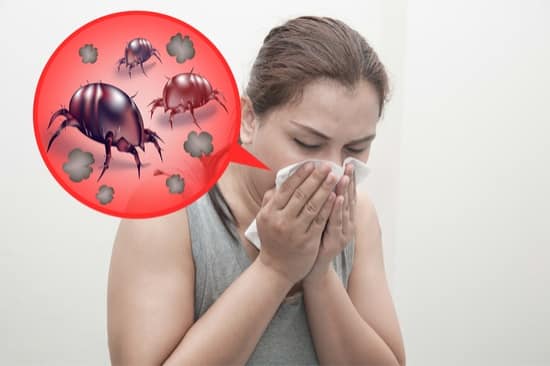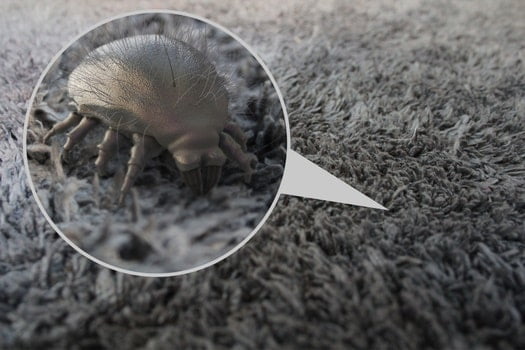Bed bugs and mites are tiny creatures that can infest your home or body. They are both pests – they make our lives difficult, and cause stress and anxiety. However, they are totally different creatures.
Bed bugs are insects. They are about the same size, shape, and color as an apple seed. They live around the home, usually in the bedroom, and feed on human blood. Mites are arachnids, and are much smaller – most are invisible to the naked eye. Scabies mites live and breed under the skin, but dust mites do not bite humans at all.
In this article, you’ll learn exactly what bed bugs and mites are. We’ll go through their similarities and differences in appearance, behavior, and symptoms. We’ll also advise you on which treatment option works the best.
What Are Bed Bugs?
Bed bugs, scientific name Cimex lectularius, are parasitic insects. They cannot survive without drinking blood. Bed bugs are particularly keen on human blood.
It’s a myth that bed bugs only appear in dirty homes. You can pick bed bugs up at any infested house, apartment, hotel, or public place. They climb onto your clothes or luggage and come home with you.
Bed bugs seek out secluded spots such as crevices in the mattress, box spring or headboard. This is where they rest, defecate, mate and lay eggs. When it’s time to feed, they’ll find a human to bite.
If you’ve got bed bugs, you’ll know it. Bed bug bites usually occur while you’re asleep, and are often itchy, red, and raised. They’re sometimes mistaken for mosquito bites or hives.
Some people develop no reaction to bed bug bites. However, you’ll notice other tell-tale signs, such as dark fecal spots around the bedroom, and cast shells (bed bug ‘skins’).
Bed bugs reproduce quickly. Severe infestations can cause psychological trauma, anxiety, and insomnia. Infestations are notoriously hard to get rid of, and often require a professional exterminator.
What Are Mites?
Mites are tiny arachnids, belonging to the same class as spiders and ticks.
There are over 40,000 different types of mite. As you might expect, they vary a lot in appearance and behavior. Not all of them are parasites, and not all affect humans.
Most kinds of mite are extremely small – less than 1mm long. Many cannot be perceived with the naked eye, or are incredibly hard to see.
It’s possible to play host to mites without knowing it. For example, according to the Indian Journal of Dermatology, between 23% and 100% of people have mites called Demodex living in our eyelashes. Fortunately, most sorts of mite (including these) are entirely harmless.
There are, however, some kinds of mite that are considered pests. Two of the most common mites that cause undesirable symptoms in humans are dust mites and scabies mites.
Scabies mites are parasites that live under the skin, and can cause extremely itchy rashes. Dust mites do not feed on humans directly, but live around the home, eating our dead skin cells that naturally fall off. Their presence can cause allergic reactions in some individuals.
Bed Bugs vs. Mites
Now that you know what bed bugs and mites are, let’s compare them with each other. We’ll cover all the main similarities and differences between bed bugs, scabies, and dust mites, so that you can learn to identify bed bugs at home.
How Do You Catch Them?
Bed bugs transfer from home to home in two main ways.
The first is by hitching a ride on clothes, luggage or personal belongings. For example, if you put your suitcase down on an infested hotel bed, the bugs may crawl inside.
The second way is by entering your home inside used furniture. For instance, you may bring home an infested couch from a garage sale.
Scabies mites are almost always transmitted through prolonged skin-to-skin contact with someone who has them. They cannot live outside the body for very long. However, in rare cases, you may catch scabies by sharing beds and towels.
Dust mites are extremely prevalent – up to 80% of homes have them. They have lived alongside us for almost all of human history. As they are invisible to the naked eye, their presence usually goes unnoticed, unless you’re allergic to them. Nobody really knows how they spread.

What Do They Look Like?
Bed bugs and mites are small, crawling, oval-shaped creatures. However, that is really where the similarities end.
Being insects, bed bugs have six legs. They are about 4.5mm (3/16 inch) long and reddish-brown in color – many people liken their appearance to apple seeds. They have short antennae and visibly segmented bodies. Bed bug nymphs (juveniles) are smaller, and cream to pale brown in color.
Mites, on the other hand, are arachnids. Dust mites look remarkably like spiders, with their eight long legs and pointed chelicerae (mouthparts). Scabies mites are also eight-legged, though their legs are short and fat. Neither species have antennae or segmented bodies.
However, describing dust mites and scabies is futile: they cannot easily be seen with the naked eye. Scabies mites are so tiny that they look like white pinpricks. Dust mites can only be seen under a microscope.
How Do They Behave?
Bed bugs and scabies are both parasites that feed on humans. Bed bugs drink human blood, and scabies mites feed on our skin. They are both classified as ectoparasites, as they do not live inside our bodies.
However, bed bugs only come into contact with us to feed. Most of the time, they live in our furniture and fixtures around the home. Scabies mites live on our bodies permanently. They burrow shallow tunnels underneath our skin to feed and lay their eggs.
Dust mites, on the other hand, are not parasites. Though they eat our skin, they do not crawl onto our bodies to do it. Instead, they eat dead skin that naturally falls off and forms dust around the home. They rarely come into contact with us.
What Are the Symptoms?
Bed bugs bite us to feed on our blood. Though the bite itself is tiny, bed bug saliva triggers an allergic reaction in most people.
Bed bug bite marks are typically round, red, raised, and itchy. They can appear anywhere on the body, usually in small clusters. Some people do not react at all, however.
The presence of scabies mites triggers a reaction in everyone. Scabies rashes comprise lots of tiny, pimple-like bumps, which can blend together to look like one large red patch. The rash is intensely itchy, and may be scaly. The most common places for the rash to manifest are in the skin folds.
- The wrists and hands, particularly between the fingers
- Behind the elbow or knee
- Around the belly button, genitals, and breasts.
In severe cases, you might be able to see the “tunnels” in your skin.
Dust mites have different symptoms altogether. Most people who have dust mites in the home will not be aware that they’ve got them, as they don’t come into contact with our skin.
However, if you’re allergic to dust mites, you’ll experience typical allergy symptoms. This may include sneezing, red or itchy eyes, a runny nose, and congestion.
How Do I Get Rid of Bed Bugs and Mites?
Now that you understand the difference between bed bugs, scabies mites, and dust mites, let’s discuss the treatments for each.
Bed Bug Treatment
Bed bugs are one of the most difficult parasites to deal with.
Most store-bought insecticides and home remedies have a very limited success rate. This is because bugs can crawl into the tiniest crevices of your home, where the treatment won’t reach them.
The only sure-fire way to get rid of bed bugs is to have your home heat-treated by an exterminator. Bed bugs die at temperatures above 140 degrees Fahrenheit, and there’s nowhere they can hide if your whole home is heated.
While you’re waiting, you can try to keep numbers down. Wash all of your bedding regularly at 140 degrees, and use a mattress encasement so that bed bugs can’t get inside.
Vacuum your home weekly and dispose of the vacuum contents in an outside trash can. You can also purchase bed bug interceptor traps to monitor how big the infestation is.
Scabies Treatment
Scabies is a skin infection, and is easier to deal with.
First, visit your doctor to make sure that it’s scabies. They’ll prescribe you a topical scabicide treatment that you should regularly apply over your whole body.
As the mites can’t survive outside of your body, you don’t need to treat your home. However, you should wash all of your clothing, bedding, and towels in very hot water regularly, to kill any mites that may be present.
Dust Mite Treatment
Unfortunately, there is no way to eradicate dust mites from a house or apartment. They are tiny and remarkably resilient. However, there are ways to make your allergy easier to deal with.
First, visit an allergy specialist to make sure that it is dust mites that you’re allergic to. They may recommend antihistamines, nasal steroids or decongestants.
Though you can’t get rid of dust mites completely, you can reduce their numbers. Regularly dust, vacuum, clean your carpets and mop hard floors. Wash bedding, rugs, curtains and stuffed animals on high heat at least weekly. Switch to synthetic bedding, as dust mites love natural fibers like down and cotton. You should also wear a mask while cleaning your home.
If you still aren’t sure what sort of infestation you’re dealing with, we’d recommend visiting a doctor to have your symptoms examined. Scheduling a consultation with an exterminator is also a good idea – if there are any bed bugs lurking in your home, they’ll find them.


I have an infestation that is not matching any scabies or dust mite criteria. They are in my rug and on my ceiling & walls. They were here when I moved in. Neighbors have them also. I must be allergic because when I get bit it feels like a real painful shock or stab. They burn and when you mess with them, others get agitated. Their all over me, even in my nose. The only ones that itch are the ones in my hair. Any suggestions on how to get rid of them on me and my neighbors and my apartments? Thanks, Tired of our uninvited guests